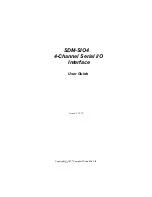
User Manual
DIC324
Table 3-12: Control register
Address
D7
D6
D5
D4
D3
D2
D1
D0
BA + 7
ST_RDY
ERR
-
-
CH3
CH2
CH1
CH0
BA + 8
T7
T6
T5
T4
T3
T2
T1
T0
BA + 9
G7
G6
G5
G4
G3
G2
G1
G0
CH[3:0]
Code of input, connected to the frequency meter ( 0 ... 15).
ERR
Measuring error. The bit is set if the frequency meter is overfilled (F[15:0]>
0xFFFF). The bit is reset in case of any writing to the port BA+7.
ST_RDY
Bit Start / Frequency meter readiness. Bit setting starts the frequency
measurement process, bit reset interrupts the measurement process (in
which case, the state of the
data register
is not determined!
). Bit is reset
automatically if the measurement is successful (N-periods of the measured
frequency are obtained, starting from the falling edge), or meter is overfilled.
Bit reading enables to determine meter readiness to the next measurement
(state 1-ready, 0- busy).
T[7:0]
Code of the number of periods of the frequency measured (from 1 to 255,
code
T[7:0]=
0 is not used
).
Warning!
G[7:0]
Filling frequency code (from 1 to 255, code 0 is not used).
Filling frequency in MHz is determined using the formula:
F=25 / (G[7:0]+1);
E.g., in order to get the filling frequency of 1 MHz, the code G[7:0] = 24 should be
set.
16-bit register of data
is available through the reading via the word port with the
address
BA+Ah
and has a format:
Table 3-13: Register of data
Address
D15
D14
D13
…
D3
D2
D1
D0
BA + Аh
F15
F14
F13
…
F3
F2
F1
F0
F[15:0]
16-bit code of duration of
N-periods
of the measured frequency (number of
the measured frequency periods is set
Code of time intervals is not saved after measuring and should be set
before each measuring.
38







































